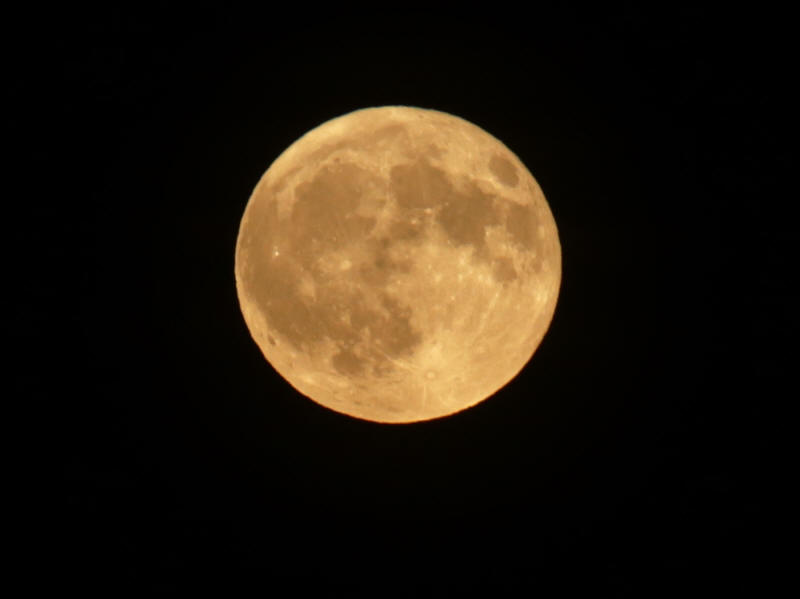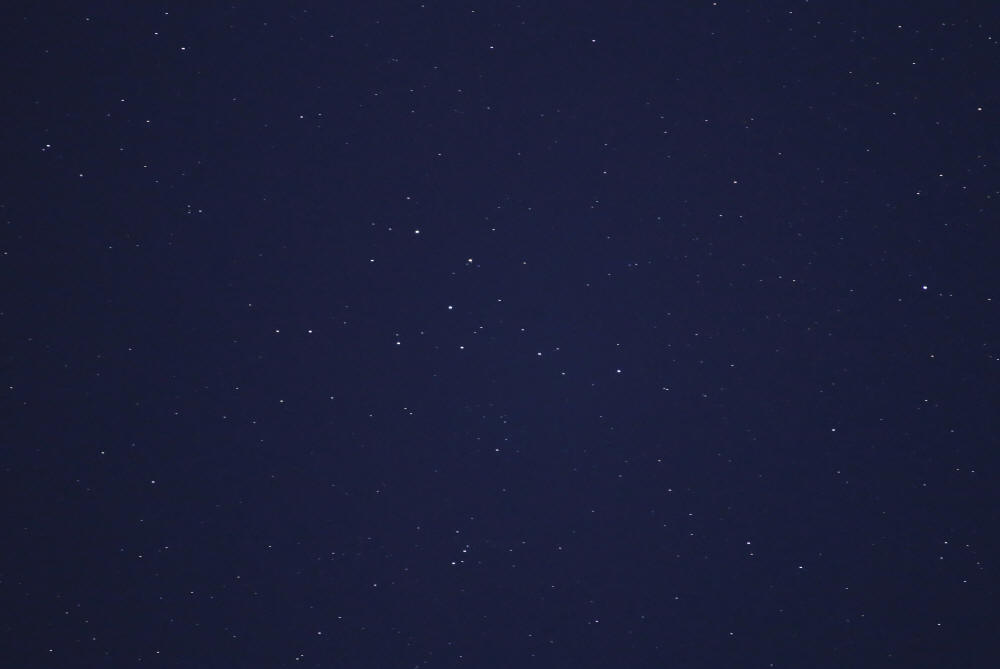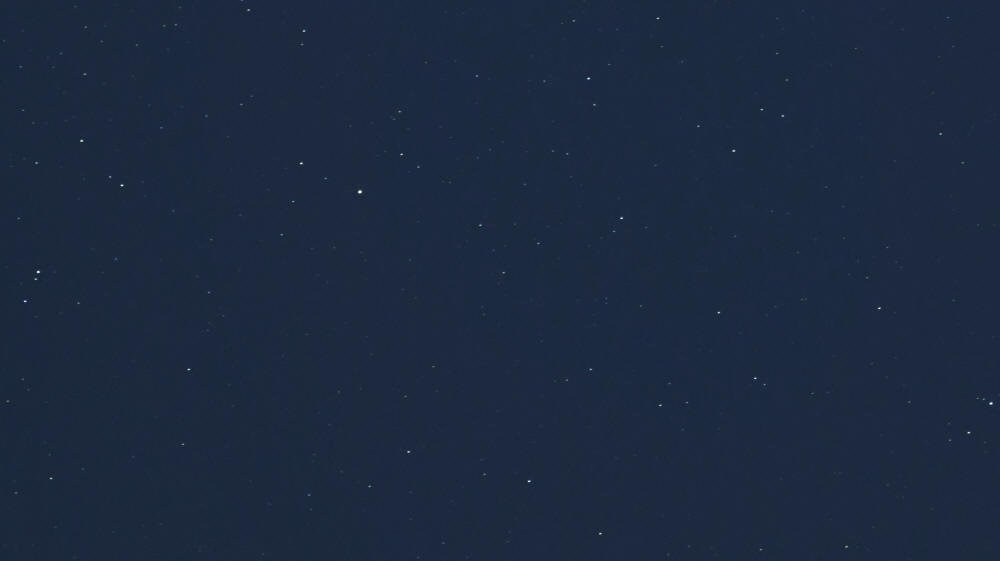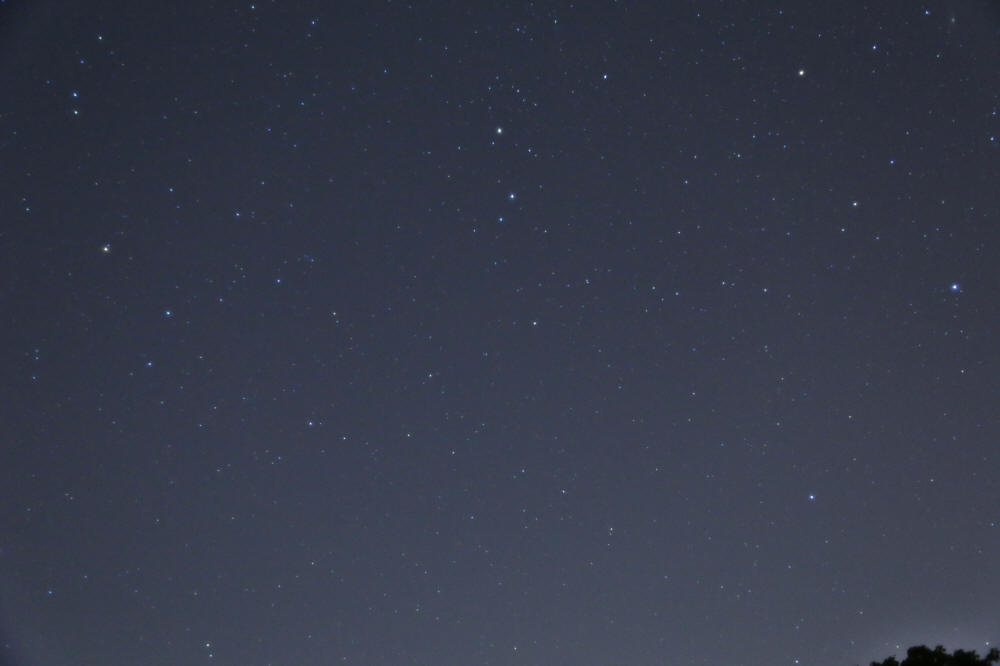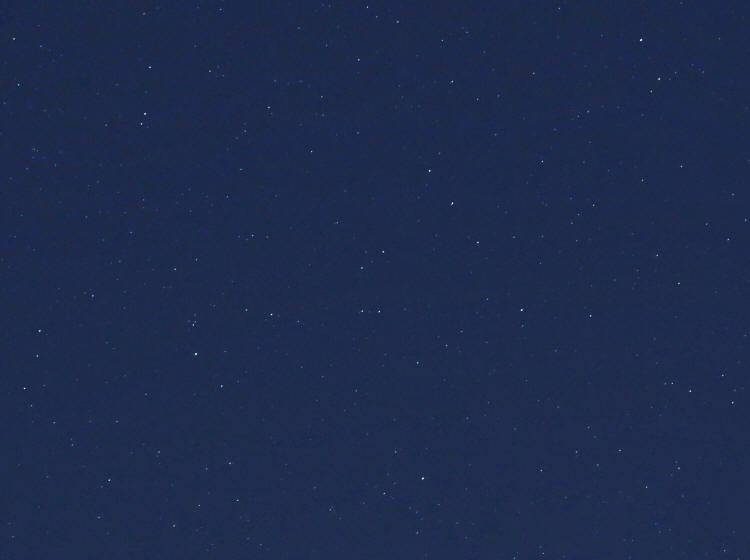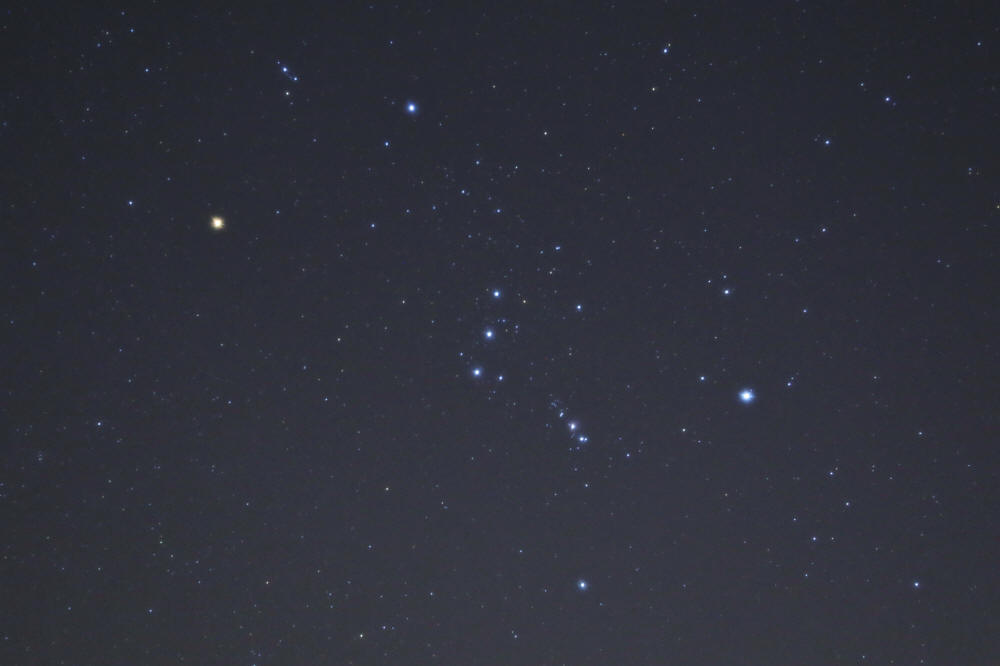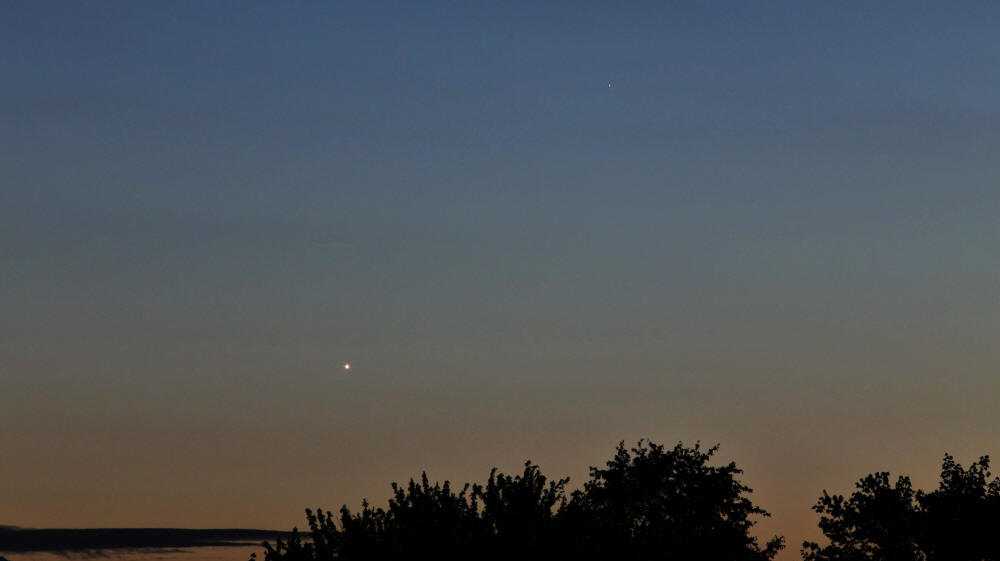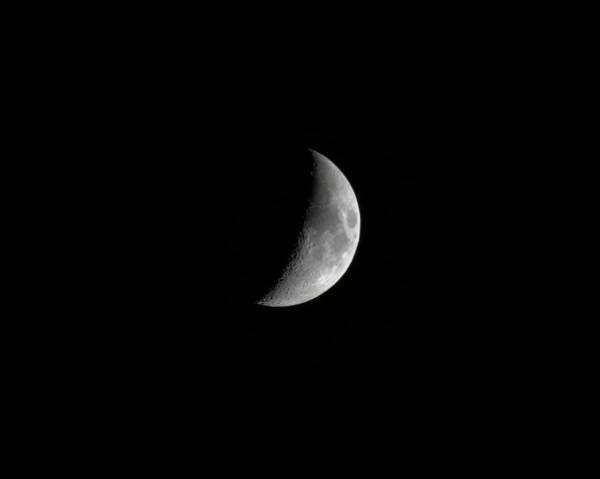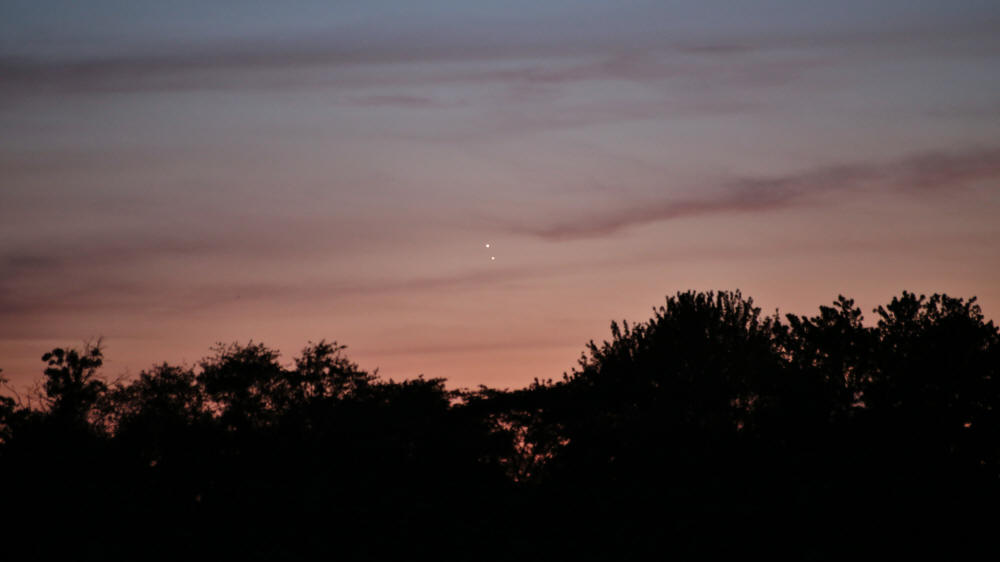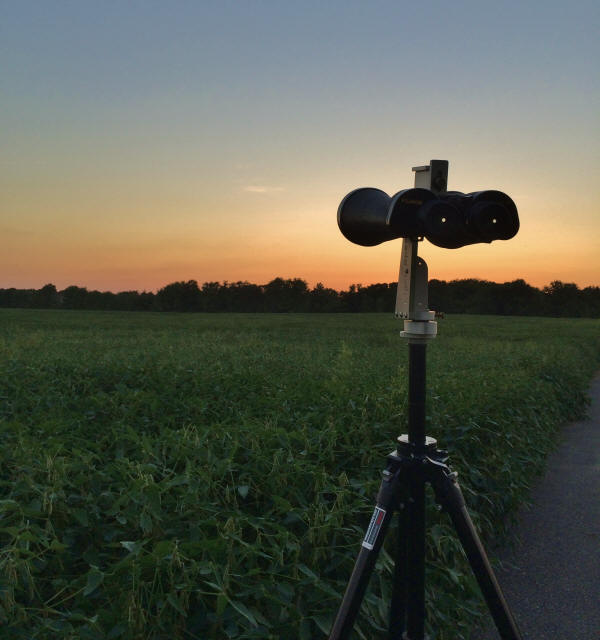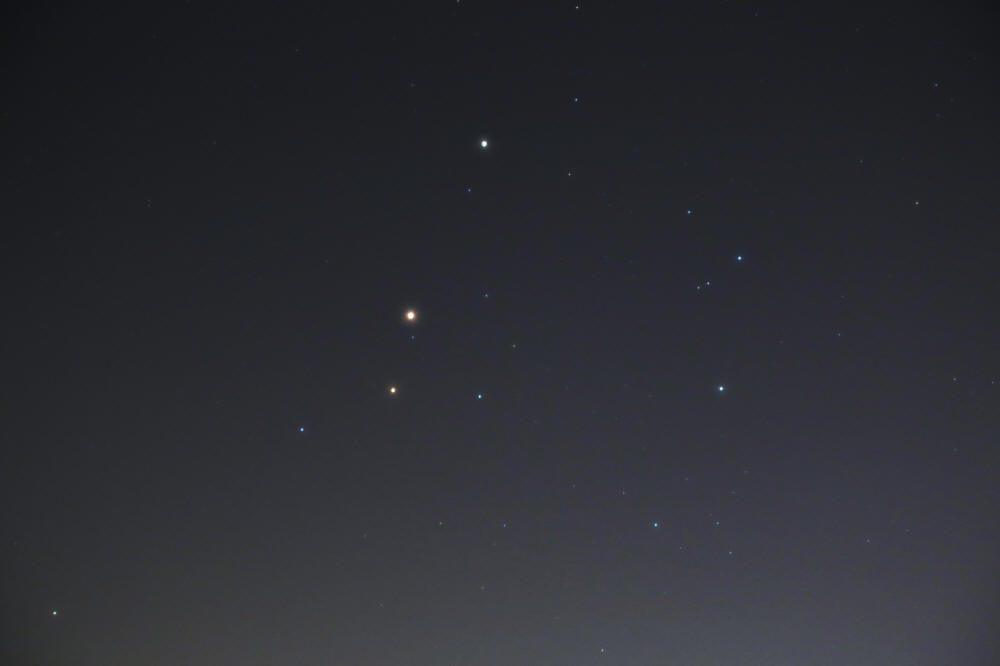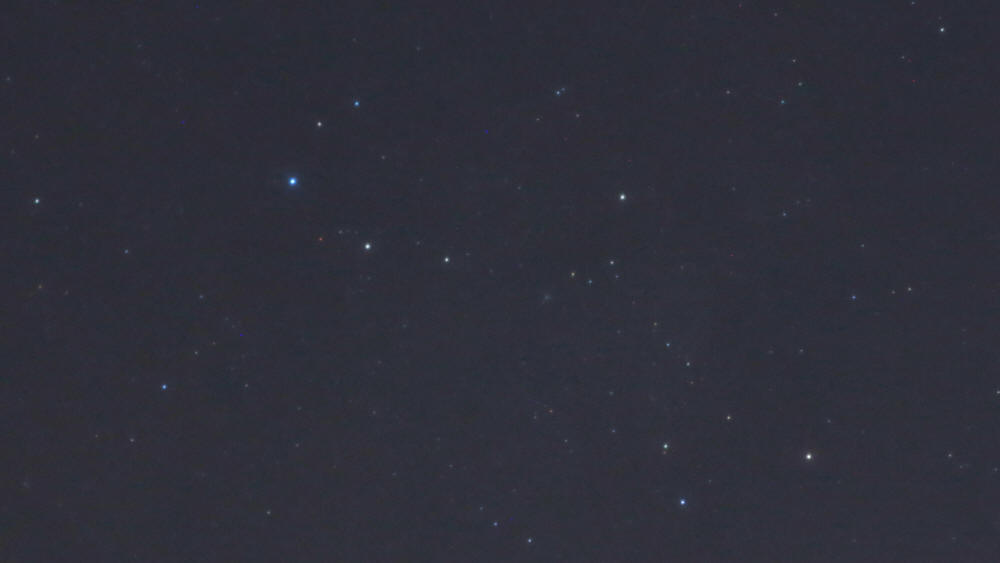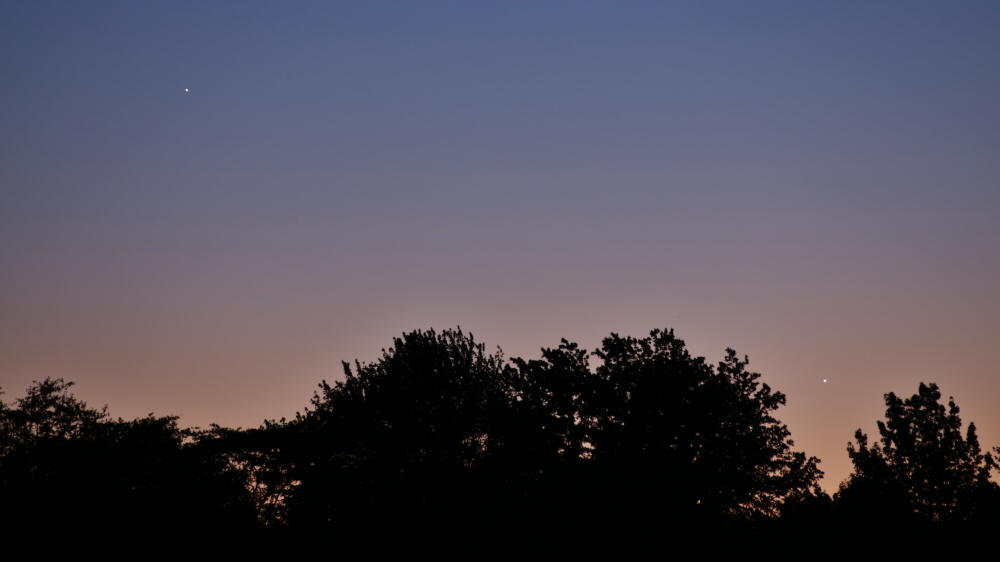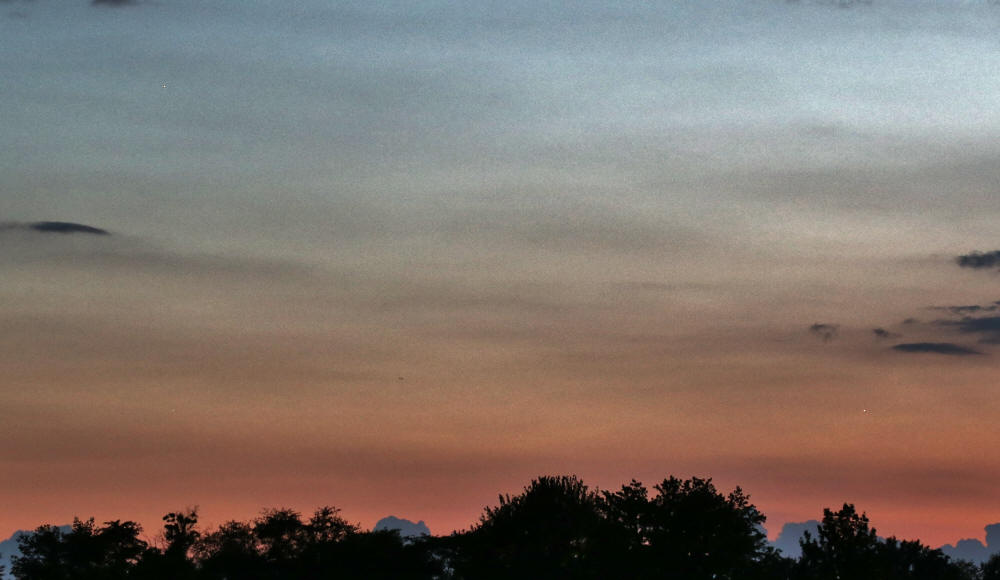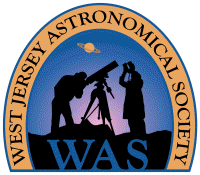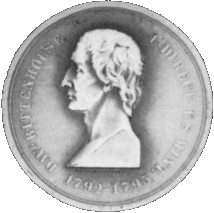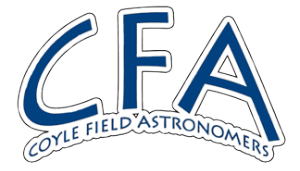The Rising Harvest Moon
September 16, 2016
This month's Full Moon was on September 16, 2016, at 3:05 pm EDT and is this year's Harvest Moon (since the equinox will be on September 22nd at 10:21 am). There was also a penumbral eclipse earlier in the day, the mid-point occurring at 2:54 pm when the Moon was still 45° below the horizon for observers in our area (nominally 40°N, 75°W). This image was captured at 7:41 pm, 27 minutes after moonrise at 7:14 pm and 35 minutes after sunset at 7:06 pm, when the moon was at 4½° altitude. It was taken from Swede Run in Moorestown, NJ, with a Canon 6D digital SLR camera and a Canon 400 mm f/5.6L lens on a fixed tripod (cropped to roughly a quarter of the original size to a field about 1.3° wide x 1.0° high). It was exposed 1/500 second at f/11, ISO 3200 and daylight white balance. The moon's golden color (because of the low altitude) is essentially the same in the picture as it was visually at the time. However, click the picture (or click here) for a larger version with increased color saturation that better shows a thin rim of color at he upper limb (greenish) and the lower limb (reddish) due to atmospheric chromatic aberration. Thanks to Steve Mattan's web page for pointing out this effect.
The Coathanger Asterism
September 16, 2016
The Coathanger asterism is also known as Brocchi's Cluster and Collinder 399, even though it's no longer considered a star cluster. This image of it was captured on September 16, 2016, at 10:19 pm EDT from Swede Run in Moorestown, NJ, despite the presence of the full Harvest Moon 70° to the east. Taken with a Canon 6D digital SLR camera and a Canon 400 mm f/5.6L telephoto lens on a fixed tripod, then cropped to about 80% of the original size yielding a field of view 4.1° wide x 2.7° high. Exposed 2 seconds at f/5.6, ISO 5000, 4200K white balance. Both the camera and the picture were rotated somewhat to present the Coathanger in a "normal" hook-up orientation. When observed in binoculars, it generally looks "upside down." From a dark site on a moon-free night, the Coathanger is visible to unaided eyes as a small fuzzy spot in the constellation Vulpecula on the western side of the Summer Triangle, about a third of the way from Altair to Vega. Mouseover for labels. As suggested by the increasing values of the Flamsteed numbers from left to right, east is to the right.
Neptune in Aquarius
September 12, 2016
On September 12, 2016, the sky was quite clear, so I went to Swede Run in Moorestown, NJ, even though there was a bright gibbous moon in the sky. I wanted to spot Uranus and Neptune in the late evening sky rather than during the pre-dawn hours I saw them earlier in the day. Around 11:30 pm EDT, magnitude 5.7 Uranus was 81° from the 84% illuminated moon and easy to see with 10x50 binoculars. However, magnitude 7.8 Neptune was only 38° from the moon and a borderline object in the 10x50s. Here's an image of Neptune 1.5° west of Lambda Aquarii at 11:37 pm (mouseover for labels). Lambda is about 9½° southeast of the Water Jar asterism in Aquarius, which is out of the frame at the top in this picture. Captured with a Canon 6D digital SLR camera on a fixed tripod and a Canon 100 mm f/2.8L macro lens, cropped to a field 9.5° wide x 5.3° high). Exposed 4 seconds at f/2.8, ISO 1250, 4000K white balance. Neptune was at opposition on September 2, 2016.
Uranus in the Ropes of Pisces
September 12, 2016
Mouseover the picture for labels. Mouseover here on the blue text to show a labeled finder path for Uranus.
After finishing with Orion in the early morning hours of September 12, 2016, I wanted to show the position of Uranus in the Ropes of Pisces. This image was captured at 4:50 am EDT with a Canon 6D digital SLR camera on a fixed tripod and a Canon 24-105 mm f/4L zoom lens (with a diffusion filter) set to 32 mm focal length. The field is 58° wide x 41° high. Exposed 10 seconds at f/4, ISO 3200, custom white balance. Uranus will be at opposition on October 15, 2016.
The image below with Uranus was also taken on September 12, 2016, but at 11:50 pm EDT. The ropes of Pisces were more vertical then. Uranus is at the end of a distinctive row of three "stars" (actually, two stars and a planet). Mouseover for labels. Taken with a Canon 6D digital SLR camera on a fixed tripod and a Canon 100 mm f/2.8L macro lens, then cropped to about 58% of the original size for a field 11.1° wide x 8.3° high. Exposed 4 seconds at f/4, ISO 1600, 4000K white balance. Sky and Telescope has a printable finder chart for Uranus and Neptune covering June 2016 to March 2017.
The Constellation Orion
September 12, 2016
The morning of September 12, 2016, was refreshingly cool (about 60°F) and fairly clear, so I made a pre-twilight visit to Swede Run in Moorestown, NJ. Astronomical twilight would begin at 5:06 am EDT and sunrise would be at 6:39 am. Orion, perhaps the most obvious of all constellations, was duly prominent and presages the coming of winter cold. Bob KIng has a nice article at Sky & Telescope about observing Orion on late summer mornings. This image was captured at 4:20 am with a Canon 6D digital SLR camera on a fixed tripod and a Canon 24-105 mm f/4L zoom lens (with a diffusion filter) set to 50 mm focal length, then cropped lightly (82% of the original frame for a field 32° wide x 22° high). Exposed 6 seconds at f/4, ISO 3200, custom white balance. Mouseover for labels.
Venus and Porrima
September 7, 2016
On the evening of September 7, 2016, Venus was 2° from the well-known double star, Porrima (Gamma Virginis), and it has moved 11.2° east of Jupiter in the eleven days since its close encounter with it on August 27 (scroll down for a picture). The movement of Venus from Jupiter at this time is very nearly at a rate of 1°/day, which not coincidentally, is about the rate of the Sun's eastward trek. At magnitude +2.8, Porrima is 6.7 magnitudes, or 480x dimmer than magnitude -3.9 Venus. Taken at 8:02 pm EDT from Swede Run in Moorestown, NJ, with a Canon 6D digital SLR camera and a Canon 400 mm f/5.6L telephoto lens on a fixed tripod. Exposed 0.6 seconds at f/11, ISO 1600. Cropped to a 16:9 ratio using the full width of the frame (for a field 5.1° wide x 2.9° high). Mouseover for labels.
The Moon on September 7, 2016
After Venus disappeared behind the trees on September 7, the camera was swung to the southwest for a snapshot of the 36% illuminated crescent moon at 8:09 pm EDT (first quarter is on September 9 at 7:49 am). Canon 6D digital SLR camera and a Canon 400 mm f/5.6L telephoto lens on a fixed tripod. Exposed 1/125 second at f/16, ISO 1600. Cropped to 34% of the horizontal and 41% of the vertical (for a field 1.8° wide x 1.4° high).
This picture of the moon and the preceding picture of Venus & Porrima are nothing special astronomically. Instead, they represent "first light" for my new Canon 400 mm f/5.6L telephoto lens. It's also the first field use of my new Acratech GV2 ball head (the gimbal position was used for the long lens, which worked quite nicely). I was also using my relatively new Benro TMA48CL graphite tripod legs that were part of a kit with a Benro B4 ball head (the kit was available at a significant discount and is now discontinued). I had already been using the legs for a month or so and liked them, but I wasn't as fond of the kit's B4 ball head, not so much the B4 head itself, but that type of closed-ball head vs. the open ball on the Acratech head I acquired. These acquisitions started with an inexpensive tripod kit that was a "Deal Zone" offer at B&H that I returned, but it precipitated the pursuit of a carbon fiber tripod, then a new head and then a longer telephoto lens. The Benro TMA48CL legs I acquired are no longer listed on the Benro web site, but they still have the similar TMA48CXL legs (the CXL legs are a little longer than the CL legs).
Venus and Jupiter Conjunction
August 27, 2016
On August 27, 2016, Venus (above) and Jupiter (below) were at conjunction as the former passed the latter with Venus moving eastward at a considerably faster rate than Jupiter. Circumstances of the conjunction and the close appulse are tabulated below. This image was captured from Swede Run in Moorestown, NJ, at 8:14 pm EDT, when the two bright planets were 5' 51" apart (roughly a fifth of a moon diameter) and just under 4° altitude. Taken with a Canon 6D digital SLR camera (on a fixed tripod) and a Sigma 70 to 300 mm f/4-5.6 apo zoom lens set to 300 mm focal length. Exposed 1/10 second at f/5.6, ISO 1600. The view in 16x70 binoculars was splendid, starting at 7:50 pm when they descended out of clouds into a relatively clear band of sky. Mercury, which had been a companion of Venus since mid-July 2016, was 5° south of the Venus-Jupiter pair at the time of the picture. As a result, Mercury is roughly at the 7:30 o'clock position relative to Venus and Jupiter, and since 5° is equivalent to 50x the nominal 6 arc-minute spacing between Venus and Jupiter, Mercury is out of the picture behind the trees (at ¼° altitude).
The picture below shows the cloudy sky to the west at 7:41 pm, three minutes after sunset and 33 minutes before the picture above was captured. Note some vague crepuscular rays radiating upwards from the trees on the right, while Venus and Jupiter are obscured by clouds on the left. Taken with the same camera and lens as the picture above, but set to 70 mm focal length. Exposed 1/800 second at f/13, ISO 1600.
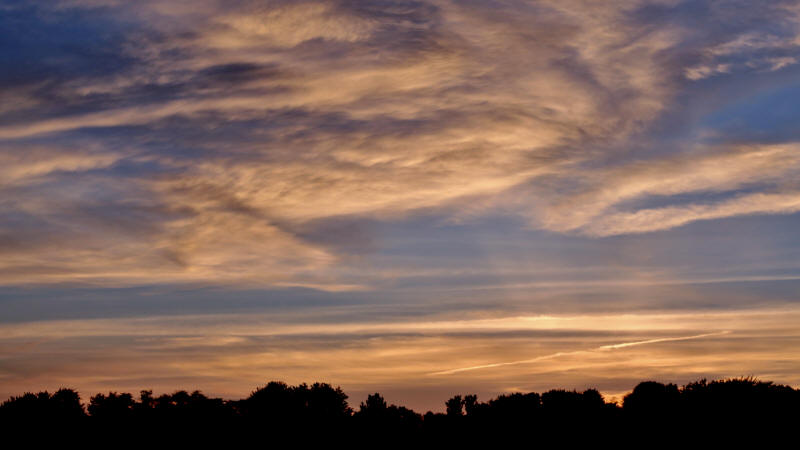
The Galilean moons of Jupiter were not visible in 16x70 binoculars (scroll down for a picture of the mounted binoculars at Swede Run on August 26), or in a small (4½" aperture?) Newtonian telescope that another observer had set up. Somewhat to my surprise, I could see both planets with unaided eyes after 8 pm. Venus was obvious and Jupiter was glimpsed at the 5 o'clock position from Venus; however, by 8:08 pm, I had no doubt that Jupiter was visible, i.e., the separation was not too narrow to preclude resolution by my unaided eyes as I had originally feared. The other observer's granddaughter (about 12 years old?) could also see Jupiter with unaided eyes.
|
Event |
Time (EDT) |
Separation |
Altitude |
|
Conjunction in geocentric right ascension: |
5:48 pm |
4′ 21″ |
31° |
|
Appulse, or closest approach (40°N-75°W): |
6:32 pm |
3′ 56″ |
23° |
|
Sunset (40°N-75°W): |
7:38 pm |
4′ 50″ |
11° |
|
Jupiter & Venus Set (40°N-75°W): |
8:36 pm |
6′ 35″ |
0° |
The 4' 21" separation and 31° altitude at conjunction were calculated for an observer at 40°N-75°W. Swede Run is about 4 miles east-southeast of where 40°N and 75°W intersect.
Venus and Jupiter Observed
August 26, 2016
Here's a view of my trusty 16x70 Fujinon binoculars set up on a Light Speed mount atop a Manfrotto tripod on the edge of a soybean field at Swede Run in Moorestown, NJ, at 7:43 pm EDT on August 26, 2016. They're pointed west towards Jupiter and Venus, a day before their very close conjunction on August 27, 2016. As soon as I arrived and set up the binoculars, Venus was spotted with them at 7:40 pm (the sun also set at 7:40 pm). Jupiter was seen in the binoculars a moment later, a degree from Venus at the 10 o'clock position. Venus, at magnitude -3.9, was brilliant (like the head-on view of aircraft landing lights) while Jupiter, magnitude -1.7, was a ghostly glowing disc, distinctly dimmer than Venus. Venus was spotted with unaided eyes at 7:46 pm, and Jupiter at 7:57 pm. After leaving Swede Run, I stopped by the golf course overlook on Creek Rd in Moorestown, and the pair was easy to see with unaided eyes. The picture was taken with an Apple iPhone 5s (4.12 mm focal length, comparable to a 30 mm focal length on a full-frame 35 mm camera). Exposed 1/120 second at f/2.2, ISO 40. Addendum: When I was at Swede Run on September 7, twelve days later, some of the lush green soybean plants in this picture had started to turn yellowish, so they were far less attractive. It won't be long, later in October, that the plants will be completely dried up and tan in color, then the harvesting contractors will be in action.
Mars and Antares Meet
August 24, 2016
In this picture, captured on August 24, 2016, at 9:36 pm EDT, the planet Mars is just east of a straight line between the first-magnitude star Antares and the planet Saturn (mouseover for labels). Mars was a similar distance on the other side of the line the evening before. As seen here, Mars and Antares are just 1°48' apart, their closest evening spacing for this conjunction. Mars will continue in direct motion eastward (left), so its distance from Antares will continue to increase too. While Antares marks the heart of Scorpius (the Scorpion), at this time, both Mars and Saturn are in the adjoining constellation, Ophiuchus (the Serpent Bearer). Taken from Swede Run in Moorestown, NJ, with a Canon 6D digital SLR camera on a fixed tripod and a Canon 24 to 105 mm f/4L zoom lens (with a diffusion filter) set to 88 mm focal length, providing a field about 23° wide x 15.5° high. Exposed 1/4 second at f/5.6, ISO 1600, custom white balance.
V Aquilae - Carbon Star
August 24, 2016
Here's the C or J-shaped asterism that straddles the border between Aquila and Scutum, best known as a guide to finding Messier 11, the Wild Duck Cluster (an open or galactic cluster). It also makes a handy guide for finding the distinctly red carbon star, V Aquilae (mouseover for labels). This snapshot of it was captured on August 22, 2016, at 9:47 pm EDT when it was due south at 45° altitude as seen from Swede Run in Moorestown, NJ. Taken with a Canon 6D digital SLR camera on a fixed tripod and a Canon 24 to 105 mm f/4L zoom lens (with a diffusion filter) set to 88 mm focal length, then cropped to a field about 14° wide x 8° high. Exposed 5 seconds at f/5, ISO 3200, custom white balance.
Jupiter and Venus
August 22, 2016
For the first time in a while, the evening of August 22, 2016, was cool and clear with low humidity, so there was none of the all-too-familiar clouds and murkiness along the western horizon after sunset. The converging planets Jupiter (upper left) and Venus (lower right), were just 5° apart when this picture of them was captured at 8:23 pm EDT (37 minutes after sunset) from Swede Run in Moorestown, NJ. At the time, they were not as obvious to the unaided eye as might be expected with the sky being about as clear as it gets around here. That's because of the shallow angle of the ecliptic after sunset at mid-northern latitudes now, so they were only at 5.38° and 3.35° altitude respectively in the still-brightish twilight. Mercury was also nearby, below-left of Jupiter but behind the trees. It was difficult to see with binoculars before being obscured by the trees, and was barely visible in another frame captured earlier. Taken with a Canon 6D digital SLR camera (on a fixed tripod) and a Sigma 70 to 300 mm f/4-5.6 zoom lens set to 300 mm focal length, then cropped lightly vertically (resulting in a field 6.8° wide x 3.8° high). It was exposed 1/6 second at f/8, ISO 800 and 4200K white balance.
Venus, Jupiter and Mercury
August
18, 2016
On August 18, 2016, the converging planets Venus, Jupiter and Mercury formed a right triangle as they descended in murky twilight over the western horizon at Swede Run in Moorestown, NJ (mouseover for labels). Jupiter and Venus were about 9° apart, while Mercury was 4° below Jupiter and 8° from Venus. With 10x50 binoculars, Venus was spotted at 7:53 pm EDT (1 minute after sunset), Jupiter at 8:04 pm and Mercury at 8:16 pm. With unaided eyes, Venus was seen 8:05 pm and Jupiter at 8:18 pm. Mercury was not seen with unaided eyes. The picture was taken at 8:22 pm with a Canon 6D digital SLR camera on a fixed tripod, and a Canon 100 mm f/2.8L macro lens (then cropped to a field about 12° wide x 7° high). It was exposed 1/15 second at f/5.6, ISO 1600. Venus was about 4½° altitude at the time.
Click here for some older images.
